For centuries humans have been foraging for mushrooms and enjoying the health and medicinal benefits they offer.
And although some people still have a fear of mushrooms, many more are learning how to identify, clean and cook gourmet mushrooms, adding new taste dimensions to their meals.
But not everyone is fortunate enough to live in an area where they can forage mushrooms.
Luckily, these days it’s easier than ever before to grow gourmet and medicinal mushrooms at home, and there are many online resources and supplies to help you get started.
But, can you grow mushrooms indoors?
Read on to discover the answer to this question and learn how easy it can be to grow fresh gourmet mushrooms at home with our step-by-step guide.
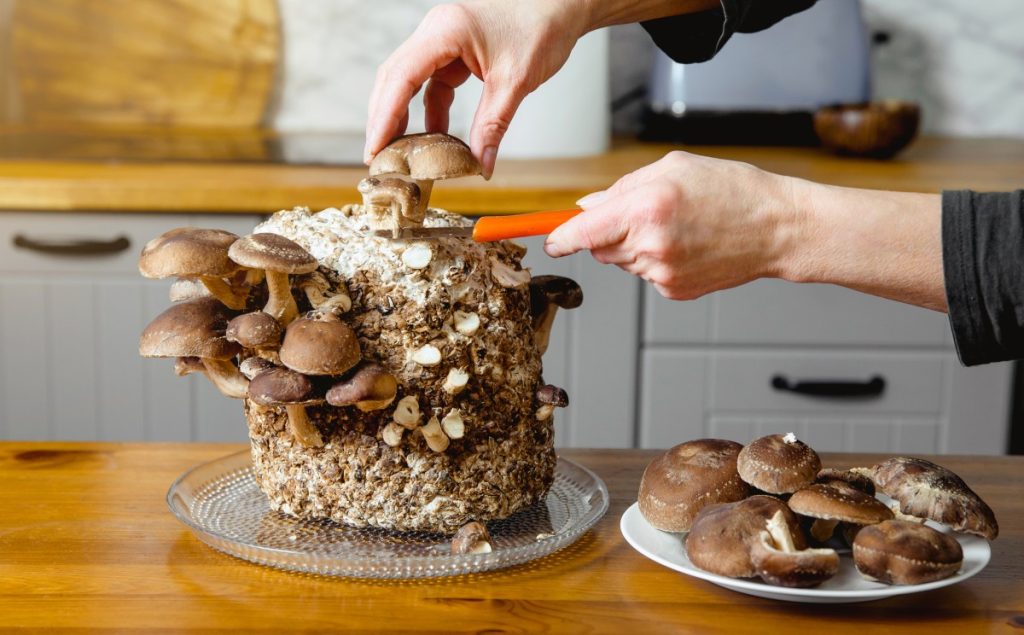
Can You Grow Mushrooms Indoors?
Yes, you can grow mushrooms indoors, and growers cultivate most of the edible gourmet mushrooms you find at grocery stores indoors.
One of the best things about mushrooms is that you don’t need much space to grow them, and even city dwellers without backyards can grow mushrooms at home.
Most indoor gardeners don’t even think about growing mushrooms. They assume it’s too difficult or that you need specialist conditions. And that’s true to some extent – indoors is not the best environment for mushrooms as they need cool, humid conditions with good airflow to thrive.
Often, household temperatures are too high and humidity levels are too low for mushrooms to grow well.
But with a little effort, you can create the right fruiting conditions for them and enjoy all the benefits of delicious homegrown mushrooms.
When growing mushrooms indoors, you have several methods and hundreds of mushroom species to choose from, and sometimes the amount of information can be overwhelming.
But don’t let the choices and information overload put you off. Growing mushrooms at home can be fun, easy and cost-effective. It’s up to you.
Perhaps you’re interested in growing a few mushrooms as a fulfilling and healthy hobby, or maybe you’re hoping to start a mushroom growing business.
Most people go through different stages as they progress on their mushroom cultivation journey.
The information below will give you an idea of the equipment and amount of time required for different stages of mushroom cultivation.
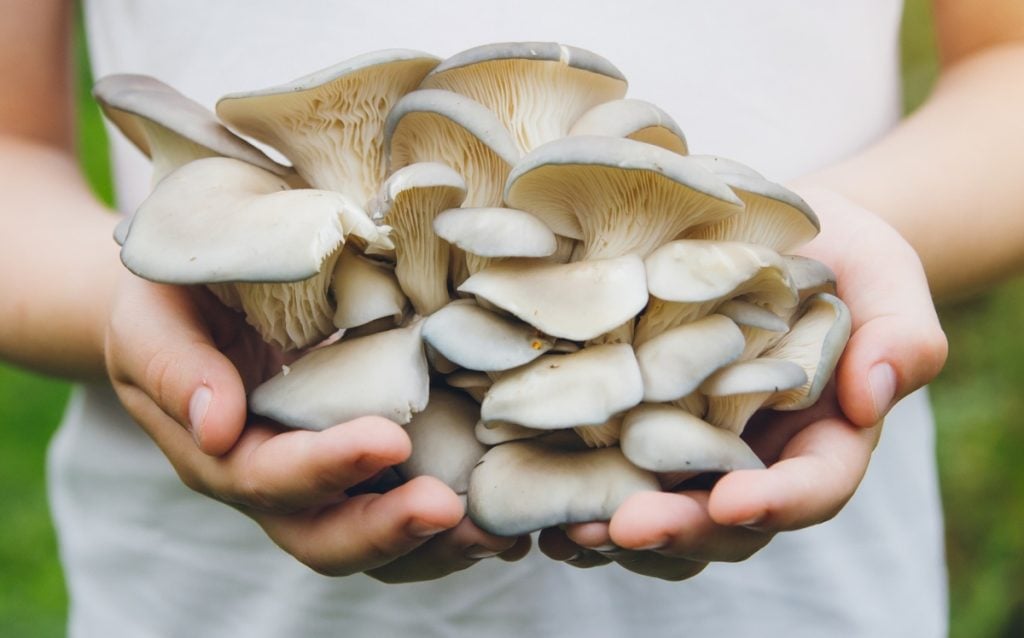
Growing Mushrooms Indoors as a Beginner
If you think mushroom growing sounds intriguing and want to try it out, we recommend starting with a mushroom grow kit.
These kits come with fully colonized fruiting blocks ready to start producing mushrooms.
The only extra equipment you need is a spray bottle to keep your mushroom kit moist.
Simply open your kit, put it in a spot with indirect light and temperatures between 50 to 75 °F (10 to 24 °C), and mist it with water twice a day.
Humidity is very important when growing mushrooms indoors. If your mushrooms are too dry, they’ll stop growing.
If you live in a dry climate, try a humidity tent made from a plastic bag to help increase humidity levels. Cut a few holes in a large plastic bag to allow airflow, and place the bag over, but not touching, your kit.
Although you can get grow kits for several species of mushrooms, we recommend first-time mushroom growers start with oyster mushrooms.
Oyster mushrooms are the easiest mushrooms to grow and also some of the quickest. It won’t be long before you see mushroom pins forming, and in under two weeks, you could harvest your first flush.
And they come in several varieties, including pearl oysters, phoenix oysters, king oysters, and colorful pink, blue, and golden oysters. You can try a few and decide which is your favorite.
If you’re in the UK, try one of our oyster mushroom growing kits.
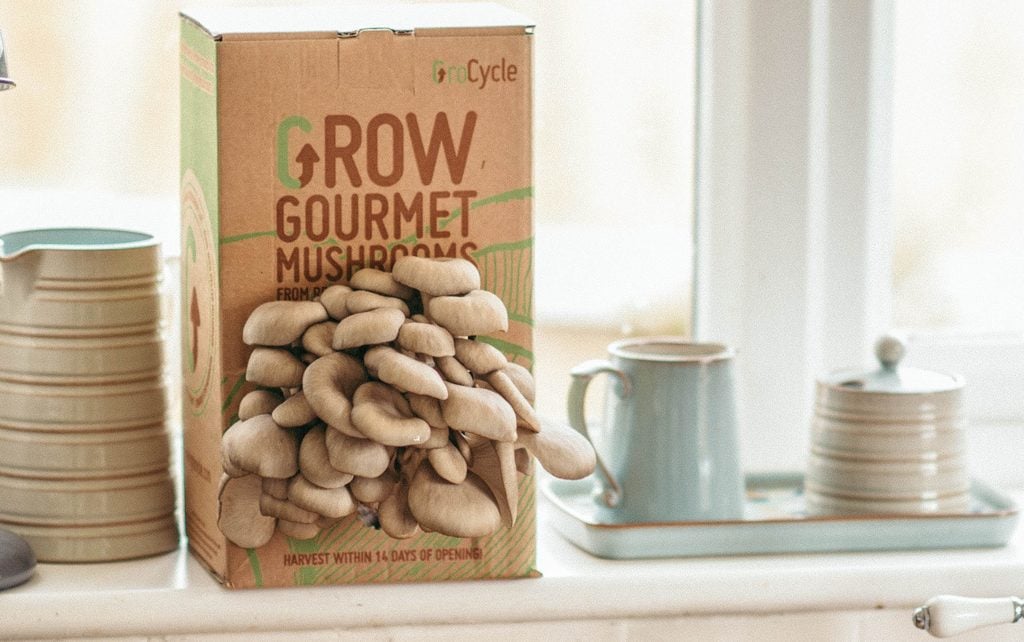
Growing Mushrooms Indoors With Intermediate Skills
Once you have tried a few mushroom grow kits, you may want to expand your knowledge, take the next step and grow more mushrooms.
This stage involves buying mushroom spawn, preparing a mushroom substrate, inoculating the substrate and creating your own fruiting blocks.
Learning about the mushroom life cycle will help you understand the process and what is happening while mushroom mycelium colonizes your substrate.
Starting with spawn and substrate increases the amount of time it takes before you can harvest your mushrooms.
Depending on the species, mushroom mycelium can take 7 to 21 days to colonize a substrate.
You can grow mushrooms indoors with a bulk substrate in bags, buckets, bottles, jars or other containers, and monotubs are a great idea if you want to cultivate top fruiting mushroom species.
At this stage, a small mushroom fruiting chamber of some sort is a good idea as they help to maintain fruiting conditions and increase your yields.
Monotubs, shotgun fruiting chambers and Martha grow tents are all inexpensive and easy to set up, and you can choose how automated you want to make them.
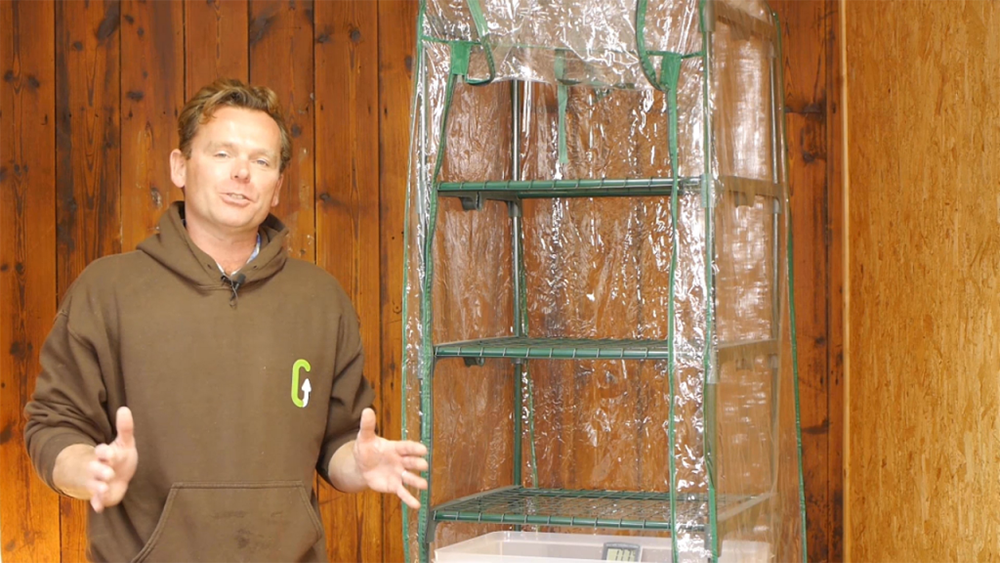
Growing Mushrooms With Advanced Skills
At this stage, growing mushrooms indoors is becoming more than a hobby, and you are ready to invest more time and space.
Can you grow mushrooms indoors year-round? Yes, you can. But to maintain fruiting conditions year-round, you’ll need to invest in a fruiting chamber.
Fruiting chambers create a controlled environment with optimal conditions and make production more reliable.
A large walk-in fruiting chamber with enough space for shelving or hanging bags is a must if you are hoping to increase production.
Hydroponics grow tents are a good option, or you could even convert a room or container into a fruiting chamber.
Before you jump in, read our article, “5 Things I Wish I Knew Before I Started Growing Mushrooms For A Living,” and learn from our experiences.
Mushroom cultivators who reach this stage sometimes like to produce their own mushroom cultures and mushroom spawn.
You can do this using mushroom spores from spore prints or cloning mushrooms using a piece of mushroom flesh.
But, producing cultures and spawn isn’t necessary for low-tech mushroom farming.
And, unless you want to grow different and unusual species, we recommend buying mushroom spawn from a reputable local supplier.
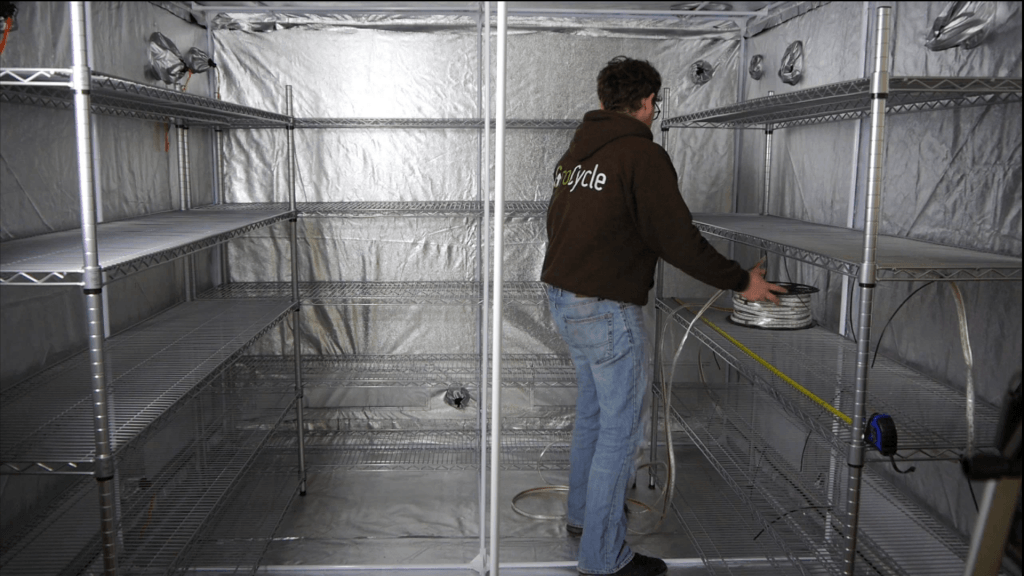
Supplies Needed to Grow Mushrooms Indoors
You don’t need a lot of equipment to grow mushrooms indoors, and beginners can start with a grow kit, thermometer and spray bottle.
If you’re growing mushrooms indoors without a grow kit, at the very least, you’ll need the following:
- Mushroom spawn
- Mushroom substrate
- Bags, buckets, jars or other containers
- Thermometer
- Spray bottle
You can add additional equipment, depending on the type of mushrooms you’re growing and how many you hope to produce.
Our mushroom growing supplies list has more information and covers everything you’ll need to set up a mushroom farm.
How to Grow Mushrooms Indoors Step by Step
When you’ve successfully grown mushrooms from a kit and want to take mushroom cultivation to the next stage, use the steps below to grow mushrooms at home indoors:
Step 1: Decide Which Mushroom Species to Grow
Before you begin, you’ll need to decide which mushroom species you want to grow.
Some things to consider when deciding are what mushroom spawn is available in your area and also what materials you can easily source locally for the substrate.
What Mushrooms Grow Well Indoors?
There are several delicious gourmet mushrooms that you can grow indoors, including:
- Oyster mushrooms
- Shiitake mushrooms
- Cremini mushrooms
- Pioppino mushrooms
- Maitake mushrooms
- Lion’s mane mushrooms
- Chestnut mushrooms
And, it’s not only edible mushrooms you should consider. Some medicinal mushrooms also grow well indoors. Reishi mushrooms, one of the healthiest mushrooms you can eat, are one of these.
If you’re new to growing mushrooms, consider what mushrooms are easiest to grow indoors?
Oysters, shiitake, pioppino, elm oysters and lion’s mane are some of the easiest mushrooms to grow indoors, with oysters being the number one choice.
You can grow oyster mushrooms on many substrates, including straw, sawdust blocks, coffee grounds and cardboard.
They’re also hardy and tolerate a wider range of temperatures than some other species of mushrooms.

Step 2: Gather Your Supplies
Once you have decided which mushrooms you want to grow, you can source your supplies.
- Mushroom spawn – Order mushroom spawn from a supplier near you. It’s best to use mushroom grain spawn when growing mushrooms indoors using bulk substrates.
- Substrate – We recommend using substrate materials that you can source locally in your area. The species of mushroom you have chosen and their substrate preference will dictate how many choices you have.
- Grow bags or containers – We recommend mushroom growing bags with filter patches specially made for mushroom growing. But you can also grow mushrooms in buckets, jars, other containers or monotubs.
- A large bucket, tub or tote for mixing the substrate and spawn (not necessary if you’re using a monotub)
- A spray bottle
Step 3: Prepare Your Substrate
Depending on your choice of substrate, preparing the substrate could mean pasteurization or sterilization.
You don’t need to sterilize substrates like straw and coco coir as they’re low in nutrients.
But substrates like amended sawdust blocks and master’s mix that contain more nutrients for the mushrooms need sterilization.
Our article on mushroom substrates has more information on the different substrates you can use and how to prepare them.
Once you’ve pasteurized or sterilized your substrate and checked that it has the proper amount of moisture, you can move on to the next step, inoculation.
Step 4: Inoculation
Inoculation is the name given to the process of adding mushroom spawn to your prepared substrate.
It’s best to inoculate your substrate in conditions that are as sterile as possible to help prevent contamination.
We find it easier to mix our grain spawn and substrate in a large clean container before adding it to our grow bags or buckets.
If you are growing mushrooms using a monotub, you can inoculate your substrate in the monotub.
Whichever method you use, ensure the spawn is evenly distributed throughout the substrate to help speed up colonization.
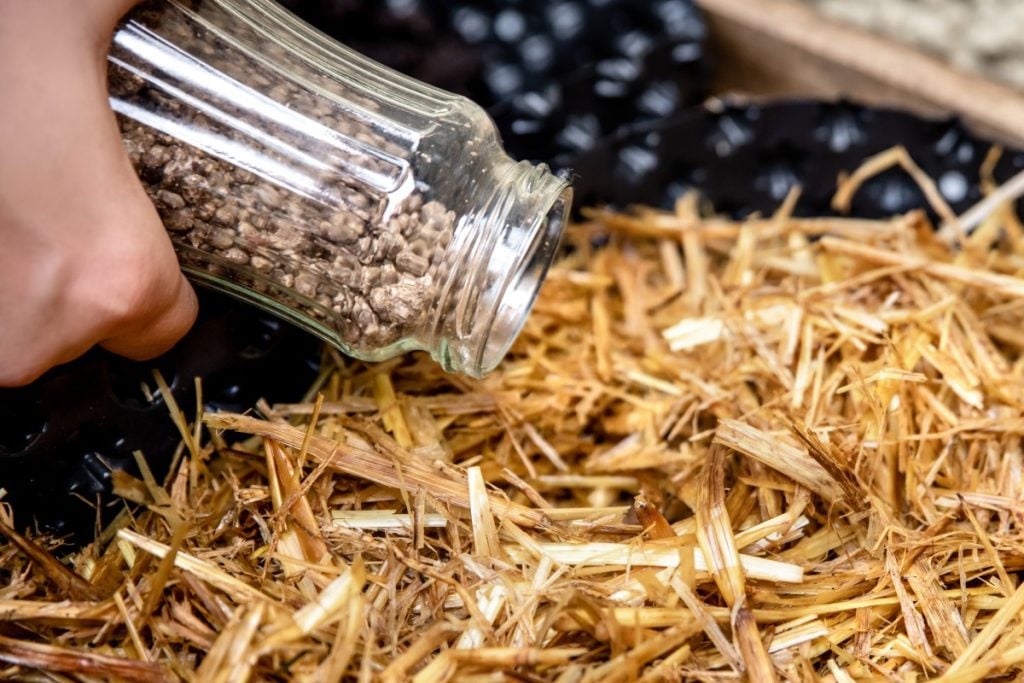
Step 5: Incubation
Once you have loaded the inoculated substrate into your bags or containers, seal them and leave them in a warm dark place for a few weeks to incubate.
During this time, the mushroom mycelium will expand outwards from the grain spawn and spread its way throughout the substrate.
This process is called colonization. During colonization, the mycelium feeds on the organic matter in the substrate.
Once the white mycelium has covered the substrate and mushrooms pins are starting to form it’s time for fruiting.
How long incubation takes depends on several factors, including temperature, spawn rate, the substrate used and mushroom species.

Step 6: Fruiting
Fruiting is the most exciting step as you can now watch your mushrooms grow.
To encourage the fungus to produce mushrooms, you’ll need to mimic their fruiting conditions in the wild.
These conditions include fresh air exchange, humidity levels of 80% and above, indirect daylight (enough to read a book) and temperatures between 50 to 75°F (10 to 24°C), depending on the species.
One of the most challenging things when growing mushrooms indoors is providing enough fresh air exchange while at the same time maintaining high levels of humidity.
A kitchen counter near a window and regular misting will be fine for easy-to-grow species like oysters and shiitake mushrooms. But for other fussier species, you’ll have to be more precise.
And this is where fruiting chambers come in handy. They make it easier to control CO2 levels, temperature, lighting and humidity.
Depending on the types of mushrooms you have chosen to grow, you could be harvesting your first flush less than two weeks after putting them in fruiting conditions.
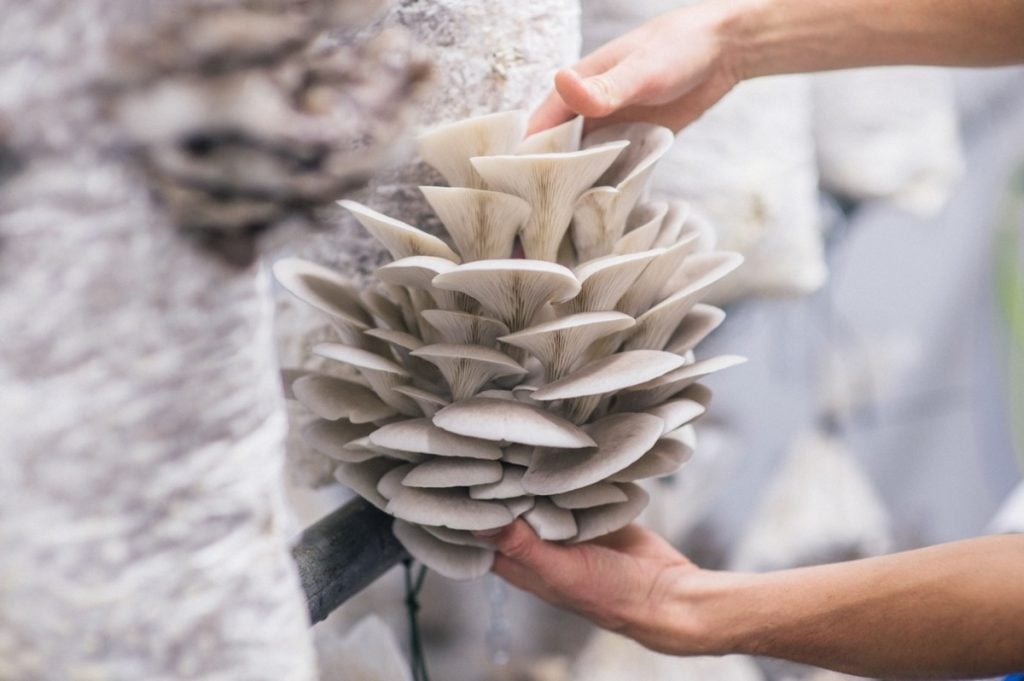
How to Grow Oyster Mushrooms Indoors
Oyster mushrooms are one of our favorite mushroom species to grow indoors, and because they’re so hardy, we highly recommend them for beginner mushroom growers.
When growing oyster mushrooms indoors, you can use a range of substrates and containers. We’ve even grown oyster mushrooms in a book.
Side fruiting species of oyster mushrooms grow well in bags or buckets, and king oysters that grow out of the soil in the wild do well in bags and monotubs.
Our ultimate step-by-step guide on how to grow oyster mushrooms has more information for you.
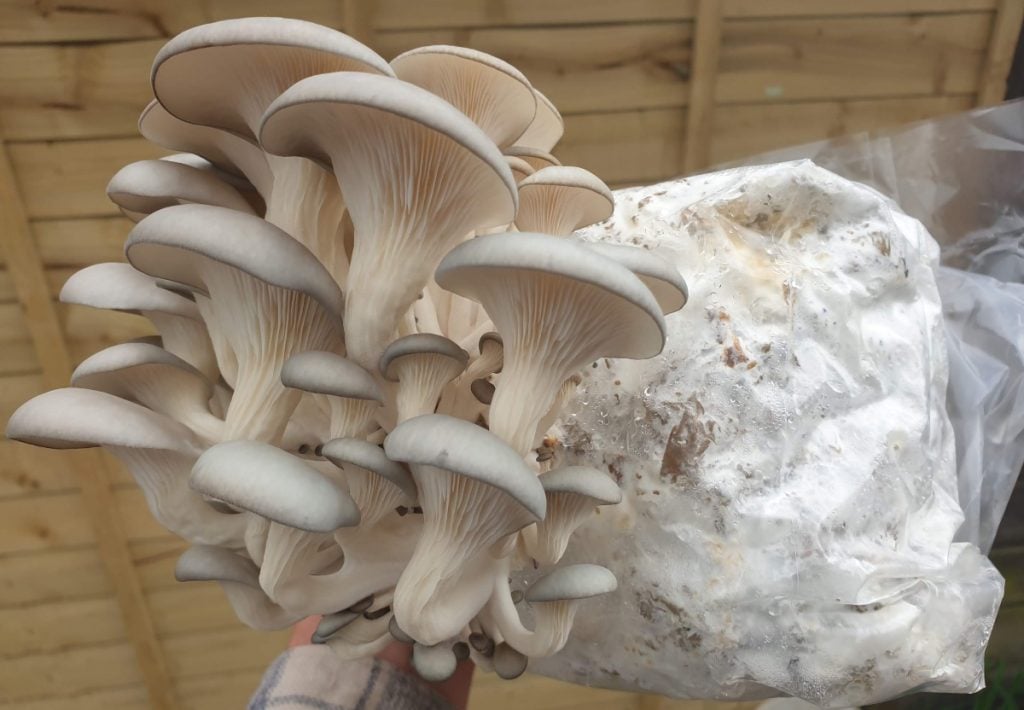
How to Grow Shiitake Mushrooms Indoors
You can grow shiitake mushrooms indoors on hardwood sawdust blocks. They particularly enjoy oak but will grow on other hardwoods like beech or maple.
Shiitakes take longer than many other mushroom species to colonize substrate. It can take two to three months for shiitake mycelium to cover the substrate.
But, unlike other mushrooms, this does not mean they’re ready to fruit. You’ll need to leave your shiitake bags for a few more weeks until the mycelium has turned brown and bumpy.
Another difference is that instead of cutting a hole in the bag or opening the top, you take the entire shiitake substrate block out of the bag for fruiting.
Our ultimate guide on how to grow shiitake mushrooms has more information for you.
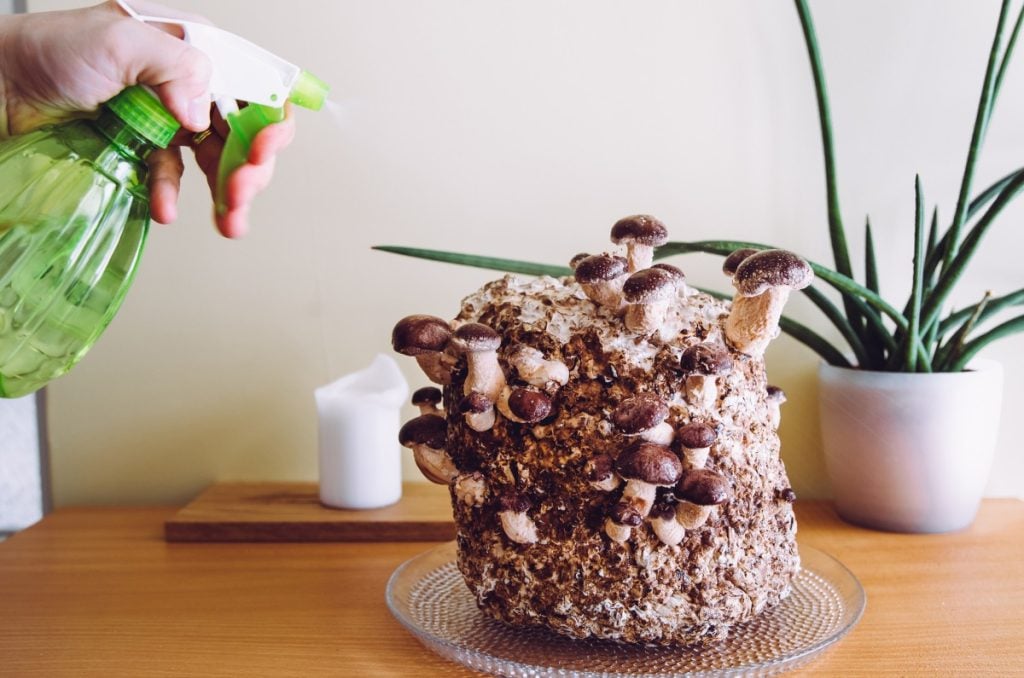
How to Grow Morel Mushrooms Indoors
Growing morel mushrooms indoors is difficult, although not impossible, and best left to more experienced mushroom cultivators.
Growers usually only have around a 40% success rate when growing morel mushrooms indoors or outdoors.
The reason morels are difficult to cultivate is because, in the wild, they’re mycorrhizal, meaning they form mutually beneficial relationships with host trees and need these hosts to thrive.
Their favorite host trees are ash, elm, sycamore, apple and wild cherry trees.
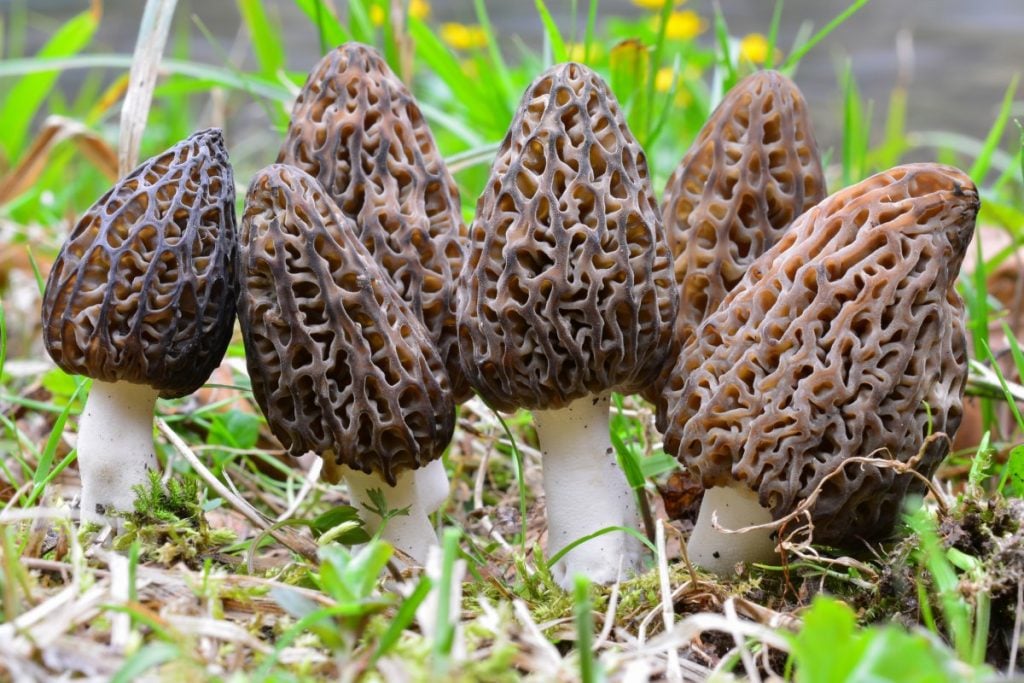
Pros and Cons of Growing Mushrooms Indoors
As more people discover mushrooms’ delicious umami tastes and wonderful health benefits, interest in growing them at home has increased.
Like most things, growing mushrooms indoors has both pros and cons.
Pros
Growing mushrooms indoors has several benefits, and the pros include:
- You don’t need much space and can grow mushrooms indoors in a small apartment.
- It’s much faster to grow mushrooms indoors than outdoors.
- You can control the environment when growing mushrooms indoors, providing better yields.
- You can grow mushrooms indoors all year round.
- Growing mushrooms indoors is a fun and educational activity.
- You know the species of mushroom you’re growing is safe to eat.
- You can grow mushrooms indoors without soil, and that means less mess.
- You get to enjoy the taste and health benefits of really fresh mushrooms.
Cons
The benefits are many, but there are some cons, and people often wonder, “Is it ok to grow mushrooms indoors?” After all, they are a fungus, and they release spores.
You can address most of the cons of growing mushrooms indoors with a well-set-up fruiting chamber. Cons include:
- Mushrooms need daily monitoring and misting with water.
- Mushrooms can have a distinct earthy smell that may become intense and unpleasant depending on how many mushrooms you’re growing.
- If you don’t harvest your mushrooms before they release their spores, you could end up with lots of mushroom spores in your house. High concentrations of spores can aggravate asthma or allergies. But, this is only a concern if you’re growing large quantities of mushrooms.
- It can be challenging to maintain the required temperature and humidity levels indoors.
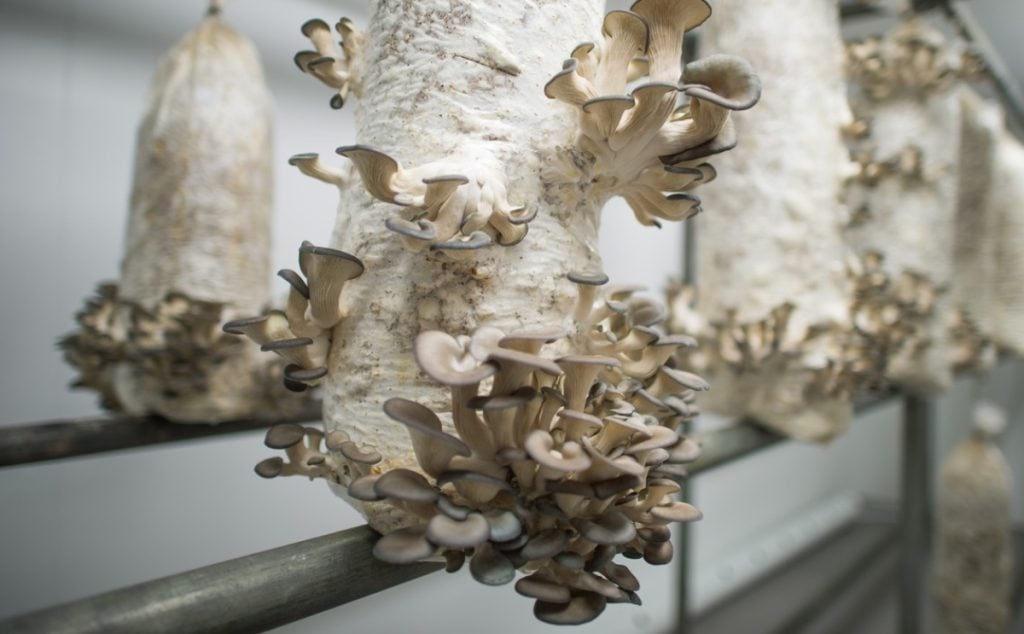
Common Issues and How to Troubleshoot Them
There are a few common problems that beginner mushroom growers tend to run into when growing mushrooms indoors, including:
1. Contamination
Mushrooms like humid conditions, and so do many other types of fungi, so there’s always a risk of mushroom contamination.
To lower the risk, wash your hands with hot water and soap throughout the mushroom growing process and clean all containers and tools with boiling water or alcohol.
Pasteurizing or sterilizing the substrate also helps kill unwanted contaminants.
2. Incorrect Moisture Levels
Too much moisture is a breeding ground for mold and bacteria, and being too dry is also a problem. Mushrooms that dry out will stop growing.
Mushroom mycelium needs moisture to thrive and produce mushrooms.
To ensure moisture levels are correct, do a squeeze test to check your substrate before inoculation.
When you squeeze a handful of the substrate, it should hold together and release a few drops of water.
Spray your mushrooms regularly while they’re growing to maintain humidity levels. A humidity regulator will help prevent any problems when using a fruiting chamber.
3. Not Enough Fresh Air Exchange
Mushrooms take in oxygen and give off carbon dioxide just like we do. If you try to grow them in an airtight container, CO2 will build up, and they’ll suffocate.
To prevent this, your humidity tent or fruiting container needs some kind of air exchange.
For beginners, this could involve making holes in your bag or tote or opening and fanning the container daily to remove excess CO2.
More advanced fruiting chambers often have fans that extract stale air and draw in fresh air.
4. Wrong Growing Conditions
All mushroom species have preferred substrates and growing temperatures.
Some species, like oyster mushrooms, produce mushrooms on a range of substrates in less than perfect conditions.
But, you’ll get the best yields when you provide them with the best possible substrate and mimic the temperature and humidity they need to grow in the wild.
Other species are fussier and will not grow unless they have their preferred substrate and optimal growing conditions.
Do some research before you choose which mushrooms to grow and pick a species that does well in your climate and will grow on substrates that you can easily source in your area.
Final Thoughts
We hope the information in this guide will encourage you to try growing mushrooms at home indoors.
If you approach it the low-tech way, it’s fun and does not need lots of expensive equipment.
Harvesting and enjoying fresh mushrooms you’ve cultivated is very rewarding, and your body will love the health benefits.
If you’re still unsure, try our introductory course and learn how to grow oyster mushrooms at home.
During this course, we take you through the mushroom growing process step by step and show you how to grow mushrooms on a small scale using simple methods and minimal equipment.
